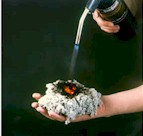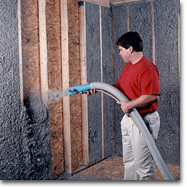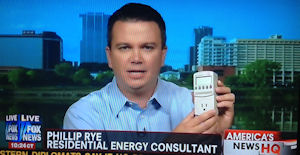|
|
Once you understand the energy saving techniques that I've learned over the
past 30 years, you'll see exactly how easy it is to have an energy efficient
home.
|
|
...And it's not as hard as you might think. Nothing I teach is new or
rocket science.
Whether you are building a new home or want to have lower utility bills
in your existing home, this information applies to you.
|
Comparison of Home Insulation For Residential Homes
|
Cellulose insulation usage is increasing all across the nation as a result of
consumer education and my nationwide seminars and radio broadcasts. Cellulose insulation is
made from recycled newspaper and is an excellent insulation and soundproofing
material.
Cellulose has several advantages including but not limited to:
|
|
The three most important factors influencing your heating and cooling bills are
-
Air infiltration
-
Air infiltration
-
Air infiltration
Cellulose fills all cracks, holes, and hard-to-reach areas.
Without getting too technical, heat is transferred in three ways.
-
Convection - transferred between air molecules
-
Radiation - transferred by electromagnetic waves (sun)
-
Conduction - transferred through a material particle by particle
Greater density of damp-spay cellulose eliminates almost all convection heat transfer.
My VHS/DVD has a demonstration that shows the convective heat transfer of cellulose and fiberglass
insulation. You can see the superior qualities of cellulose for yourself.
The demonstration also shows you the comparison of rolled vs. blown home insulation for
residential construction. When using damp-spray blown cellulose insulation, you are able to get a much
greater density, which decreases air infiltration.
Have you ever noticed that an electrician will drill a two-inch hole to pull a half-inch
wire? Every one of these holes is open to the attic for air infiltration. Cellulose insulates around
all electrical sockets and plumbing holes.
Benefits of cellulose insulation:
-
Environmentally friendly
-
By using recycled newsprint, we conserve tons of paper that would normally go
into landfills, save expensive landfill space, help recycling programs, and preserve millions
of trees.
-
Health
-
The Federal Government has
classified fiberglass as a probable cancer-causing
material. Anyone that has been around fiberglass insulation knows that it
uncomfortable to touch and breathe. The tiny glass fibers can get into your lungs and
cause major health problems.
-
Cellulose insulation poses no danger. You can roll in it, play in it,
install it, and never have the itchy skin that you have with fiberglass. The tiny glass
particles in fiberglass make microscopic cuts on your skin, and that’s why it makes you
itch. Airborne particles of fiberglass can also enter your lungs.
Quoted directly from the American Lung Association Website: "Fiberglass insulation packages
display cancer warning labels. These labels are required by the U.S. Occupational Safety and Health
Administration (OSHA) based on determinations made by the International Agency for Research on
Cancer (IARC) and the National Toxicology Program (NTP").
Noise control
-
-
Cellulose is one of the best noise control and sound insulation products.
Cellulose is fantastic for interior home sound insulation and
home theater sound insulation.
My DVD shows a convincing demonstration on the sound control of cellulose
insulation.
-
Cellulose is treated with
borate, a nontoxic chemical that is
fire, bug, and mold resistant.
|

|
As demonstrated in this picture, you can place 4" of cellulose in your hand,
put a blowtorch on it, and the insulation does not burn.
As stated by a leading U.S. manufacturer of fiberglass, "cellulose
can and does smolder at a temperature above approximately 450F degrees". Notice
that is says "smolder" and not "burns".
|
 |

 Click Here To
Listen about cellulose insulation Click Here To
Listen about cellulose insulation
Doug Rye with co- host Ron
Sherman
|
When using cellulose insulation, the need for 2x4
vs. 2x6 construction for energy efficiency is minimal. It is not necessary to have double
insulation for home energy efficiency. It can simply be done with one 2x4 wall.
Order now to discover how cellulose insulation can make your home more comfortable, more
roach-proof, more fire-proof, and more sound-proof!
Myths of cellulose insulation
»
|
Cellulose insulation causes mold and
mildew.
Cellulose insulation is treated with Broic acid which is a
mold and mildew inhibitor. When installed properly, mold and mildew CANNOT grow in
cellulose insulation. As with any building material that is installed while damp (paint,
sheetrock mud, etc.), damp spray cellulose should be allowed to air dry for 24 to
48 hours before covering and should only be damp to the touch when installed.
|
|
»
|
Cellulose insulation will settle in the walls. Any type of loose
fill insulation will settle in the walls. However, when applied correctly, damp spray
cellulose insulation WILL NOT settle. When installed correctly, a small mist of
water and glue are added to the insulation as it is sprayed. |
 |
|
»
|
Cellulose insulation will burn. The same Boric acid that resists
mold and mildew gives cellulose insulation some of its fire resistance properties. Also
the density of cellulose insulation does not allow enough air to sustain a fire. |
Click on the picture to the right for proof.
Many of you can relate to this example. What happens if you throw a
old Sears or JC Penny's catalogue in the fire? It won't burn. Why?
Because it can't get enough air.
|
 |
| 








